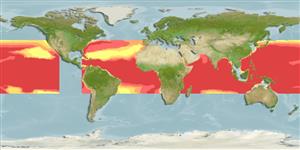Common names from other countries
>
Myctophiformes (Lanternfishes) >
Myctophidae (Lanternfishes) > Lampanyctinae
Etymology: Lampanyctus: Greek, lampas, -ados = torch + Greek, nykte = night (Ref. 45335).
Environment: milieu / climate zone / depth range / distribution range
Ecología
marino batipelágico; oceanodromo (Ref. 51243); rango de profundidad 100 - 1000 m (Ref. 44036). Deep-water; 42°N - 22°S, 82°W - 109°W
Circumglobal. Eastern Atlantic: Mauritania to Angola. Western Atlantic: isolated individuals to 42°N in the Gulf Stream but generally from 23°N to Brazil. Indian Ocean: between 10°S and 18°S. Western Pacific: Japan (Ref. 559), Taiwan (Ref. 5193), Australia (Ref. 7300), and New Zealand (Ref. 5755). Eastern Central Pacific: near Hawaii, and at western margin of the California Current region (Ref. 31442). South China Sea (Ref.74511).
Length at first maturity / Tamaño / Peso / Age
Maturity: Lm ?, range 11 - ? cm
Max length : 12.4 cm SL macho / no sexado; (Ref. 4479); peso máximo publicado: 15.40 g (Ref. 126117)
Espinas dorsales (total) : 0; Radios blandos dorsales (total) : 14 - 15; Espinas anales: 0; Radios blandos anales: 17 - 19; Vértebra: 37 - 39.
Oceanic, epipelagic to mesopelagic (Ref. 4066). Found between 475 to over 900 m during the day and between 100-500 m at night (Ref. 4066). Maximum abundance found between 300-500 m at night. Sexually mature from about 11.2 cm (Ref. 4479). Oviparous, with planktonic eggs and larvae (Ref. 31442). Minimum depth from Ref. 4066. Also Ref. 58302.
Hulley, P.A., 1990. Myctophidae. p. 398-467. In J.C. Quero, J.C. Hureau, C. Karrer, A. Post and L. Saldanha (eds.) Check-list of the fishes of the eastern tropical Atlantic (CLOFETA). JNICT, Lisbon; SEI; Paris; and UNESCO, Paris. Vol. 1. (Ref. 4479)
IUCN Red List Status (Ref. 130435)
CITES (Ref. 128078)
Not Evaluated
Threat to humans
Harmless
Human uses
Herramientas
Special reports
Download XML
Fuentes de Internet
Estimates based on models
Preferred temperature (Ref.
115969): 8 - 18.5, mean 11.9 (based on 675 cells).
Phylogenetic diversity index (Ref.
82804): PD
50 = 0.5000 [Uniqueness, from 0.5 = low to 2.0 = high].
Bayesian length-weight: a=0.00562 (0.00323 - 0.00980), b=3.16 (3.01 - 3.31), in cm Total Length, based on LWR estimates for this species & Genus-body shape (Ref.
93245).
Nivel trófico (Ref.
69278): 3.1 ±0.28 se; based on food items.
Resiliencia (Ref.
120179): Medio, población duplicada en un tiempo mínimo de 1.4-4.4 años (Preliminary K or Fecundity.).
Fishing Vulnerability (Ref.
59153): Low vulnerability (10 of 100).
